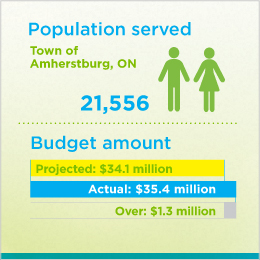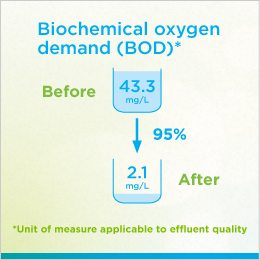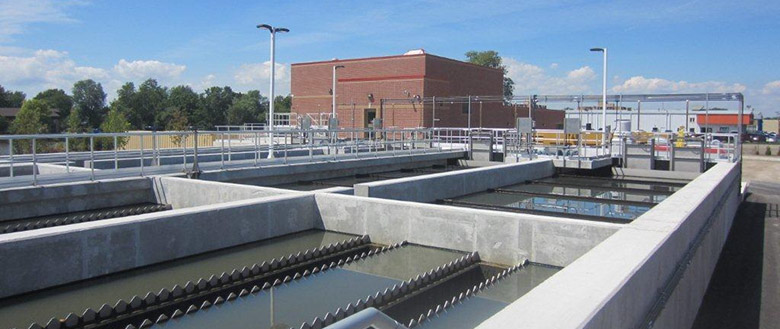This is part of a series of case studies on wastewater projects funded by the FCM's Green Municipal Fund. Each case study provides technical information, project details and tips on best practices.
Project overview
The Town of Amherstburg, ON, consolidated three sewage service areas into one. This allowed the town to close down two sewage treatment plants – one was approaching approved treatment capacity limits and the other would have needed upgrades to meet current requirements for effluent quality.
The Amherstburg Pollution Control Plant (PCP), one of the only remaining primary treatment plants on the Great Lakes, is the largest of the town's sewage treatment facilities. It treats the majority of the sewage generated by the town's urban area but was approaching its approved capacity. Upgrades to the Amherstburg PCP included improvements to the headworks and screening as well as the grit removal, primary clarification and aeration systems. The town installed secondary treatment technologies, including bioreactor tanks with fine bubble diffusion and secondary clarifiers. The town also made improvements to the dewatering system and installed an ultraviolet (UV) disinfection system and an odour control system.



Reasons for the project
- The town wanted to increase service capacity and address combined sewer overflows.
- The project was critical to meeting the goals of the Detroit River Remedial Action Plan.
Innovative aspects of the project
- The updates produced many environmental benefits in addition to higher-quality effluent: odour control, expanded capacity without extra land requirements, landscaping with native species, reduction of solid waste going to landfill and energy-efficient technology.
- The odour control system uses a biotrickling filter and a biofilter and, at the time of completion, was one of only a few full-scale installations of this type in Canada.
- The project involved a good process for equipment pre-selection, including consideration of life-cycle costs and energy efficiency.
- The town considered and evaluated various options in detail.
Best practices and key lessons
The municipality's experience with this project demonstrates some best practices and key lessons that can inform similar projects.
Select qualified contractors
- It is important to select contractors with a proven record of meeting project timelines. Originally, the construction was to have been completed in June 2012, but in reality it took until May 2013.
Engage operations staff early and provide support in adapting to the new upgrades
- To train operations staff in the new processes and technologies, the town made the operations manuals available electronically on tablets for the staff to carry with them as they were working around the plant. This made information on plant operations and equipment readily available in the field.

View of clarifiers and aeration tanks. (Credit: Town of Amherstburg)
Project benefits
This project yielded a number of environmental, social and economic benefits.
Environmental benefits
Decreased energy use and greenhouse gas (GHG) emissions: The new bubble aeration system minimizes energy consumption and GHG emissions. Additionally, a more efficient dewatering system produces fewer biosolids for transportation to a landfill.
Improved wastewater quality: Effluent quality has improved in terms of carbonaceous biochemical oxygen demand, total suspended solids and total residual chlorine. Discharge now meets stringent limits for ammonia, nitrogen, total phosphorus, E. coli and pH. Also, the increased plant capacity has reduced the number of plant bypass and combined sewer overflow events that discharge into the Detroit River.
Decreased water consumption: Treated wastewater is used for cleaning, washing or rinsing tasks in the plant. The surrounding area is landscaped with native vegetation, which is acclimatized to the existing local water conditions and requires minimal watering.
Reduced hazardous residuals: The plant uses a UV disinfection treatment process instead of gaseous chlorine.
Minimized environmental impact: The town used the existing land efficiently and did not need to procure any additional land for the plant upgrade. Specifically, the raw sewage force main and final effluent pipe both connect to their respective existing counterparts, avoiding the need to build on a greenfield site.
Protection of biodiversity and ecosystem: The higher-quality effluent resulted in improved water quality in the river. In addition, the town built a greenbelt along the edge of a pond located next to the plant, to enable pedestrian access and protect the wildlife that inhabit the pond. The project has improved effluent quality and lowered the levels of effluent overflow into the Detroit River, helping to protect the biodiversity of the river and Great Lakes.
Decreased odour pollution: A unique two-stage biotrickling odour control system has decreased the odour coming from the plant.
Social benefits
Protection and improvement of public health: Several surrounding and downstream communities in the Great Lakes area will benefit from the improved water quality and its impact on public health.
Increased opportunities for recreational activities: Improvements to wastewater quality mean better water quality in the river, which makes the water and beaches more attractive for recreational activities.
Increased access to public space: The upgrades have improved the river's water quality, leading to a reduction in beach closures. Residents and visitors can better enjoy local beaches.
Economic benefits
Reduced operating and maintenance costs: Energy-efficient technology and upgrades to the facility mean less energy use and lower operating and maintenance costs.
Deferred or avoided capital expenses: The project team took advantage of past investments in the facility, making choices that were cost-effective and highly compatible with the existing infrastructure. The project also made use of the existing outfall, the pump station and portions of the raw sewage force main and effluent pipeline to the pump station.
Increased district land values: The town expects property values around the two former facilities to rise, which would provide the town with additional revenue from the increased property taxes. Property values surrounding the Amherstburg PCP are not expected to be adversely affected.
Increased potential to attract new businesses: The additional capacity of the updated facility will allow the town to issue building permits for the service area, facilitating economic development and community revitalization.
Increased ability to attract new residents: With increased capacity to support economic development and community revitalization, the updated facility will make the municipality more attractive over the long term as the city grows.
Support for local business development: The Amherstburg PCP will serve several new areas: A sizeable area identified for heavy industrial activity, a smaller area designated for light industrial activity and two other areas designated for residential use. Providing sewage services to these areas will allow for their development and resulting positive contributions to the local economy.

Technical highlights
This project was a new facility. Technical highlights are current as of 2014.
Municipal population: 21,556
Urban/rural: urban
Treatment
- Before: Primary treatment
- After: Conventional activated sludge
Disinfection
Before:
- Plant 1 (Edgewater) — None
- Plant 2 (Boblo) — UV
- Plant 3 (Old Amherstburg PCP) — Chlorine
After: UV
Biosolids management
- Plant 1 (Edgewater) — held within treatment cells
- Plant 2 (Boblo) — held in lagoons
- Plant 3 (Old Amherstburg PCP) — beltpressed and then landfilled
Annual average daily flow (AADF)
- Before: 6.20 MLD (million litres per day)
- After: 6.84 MLD
Design capacity
- Plant 1 (Edgewater) — 1.61 MLD
- Plant 2 (Boblo) — 0.26 MLD
- Plant 3 (Amherstburg PCP) — 7.77 MLD
- Total: 9.64 MLD
Per cent of total capacity used for AADF
- Before: 64 per cent
- After: 86 per cent
Total suspended solids (TSS)
- Before: 20 mg/L
- After: 2.1 mg/L
Project contact information
Antonietta Giofu
Director, Engineering and Public Works
Town of Amherstburg, ON
T. 519-736-3664
Want to explore all GMF-funded projects? Check out the Projects Database for a complete overview of funded projects and get inspired by municipalities of all sizes, across Canada.

